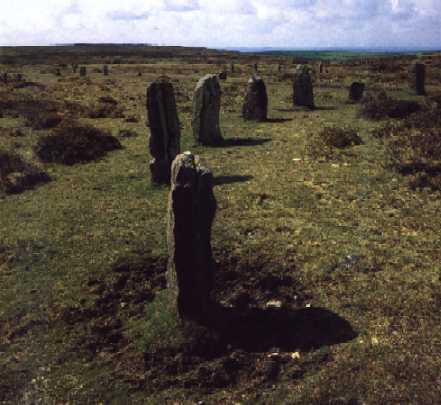|
|
|
This is sited on Bodmin Moor near Minions.
Legend has it that the Cheesewring was formed when the saints and the giants were both inhabiting Cornwall. The giants had lived there longer and were annoyed by the saints moving in and 'taking over'; putting more stone crosses up, making wells holy and taking too many tithes (taxes) from the harvest. One day St. Tue heard the giants discussing the best way of ridding the county of the saints so he decided to challenge the leader (Uther) to a trial of strength. This took the form of a rock throwing contest and if the saints won then the giants would have to renounce their wicked ways, but if the saints lost then they would have to leave Cornwall, never to return. Uther was a champion rock thrower whose speciality was balancing larger rocks on top of smaller ones, and St. Tue was very small so in theory there should have been no doubt about the result. |
|
After gathering twelve flat rocks of varying sizes Uther took first throw. The rock landed about 100 feet away towards Stowe's Hill. St. Tue picked up a rock, looked to the skies and suddenly the rock felt as light as a feather in his hand. He cast it toward the first thrown rock and it landed neatly on top. So they continued until there was only one rock left and it was St. Tue to throw. This too landed perfectly on the pile and, not wanting to admit defeat, Uther suggested that they throw 'one more for luck'. He picked up a huge stone and using all his strength threw it. It fell short of the pile, rolled back down the hill and landed at the saint's feet. As the saint prayed for holy intervention an angel, visible only to him, appeared and carried the stone to the pile. Placing it neatly on the top the angel then vanished and the saints had won. Uther promised to mend his ways and so did most of the other giants, although some went into the hills muttering about revenge.
There is another legend that says if the stones hear a cockerel crow then the top stone turns three times.

|
Near the Cheesewring is the ancient site of the Hurlers, three stone circles that were once men. Apparently they decided to 'hurl' on the Sabbath rather than attend church and were turned to stone. Like the Merry Maidens there are two Piper stones although here they stand together. The centre ring is slightly oval but the other two are perfect circles in which all the stones are the same height. Apparently if you correctly count the number of hurler stones a misfortune will befall you. |
Above is one of the Hurlers with the circle behind it. Below is just one of the circles.

The game of hurling is still played on Shrove Tuesday at St. Columb.

Between the two sites mentioned is Rillaton Barrow, which when it was excavated gave up a skeleton, a bronze dagger and a gold cup. This cup was used as a shaving mug by King George V but is now in the British Museum.
Legend says that the barrow was the home of a holy man and the cup had the magical power of never being empty. He would allow passing travellers to drink from the cup and refresh themselves but one day a huntsman decided to prove the story wrong and drink the cup dry. He swallowed cupful after cupful but still it wouldn't empty and unable to drink anymore threw the cup down and climbed on his horse. The horse staggered under the mans weight and only went a few steps before falling off the edge of the cliff. Both died.